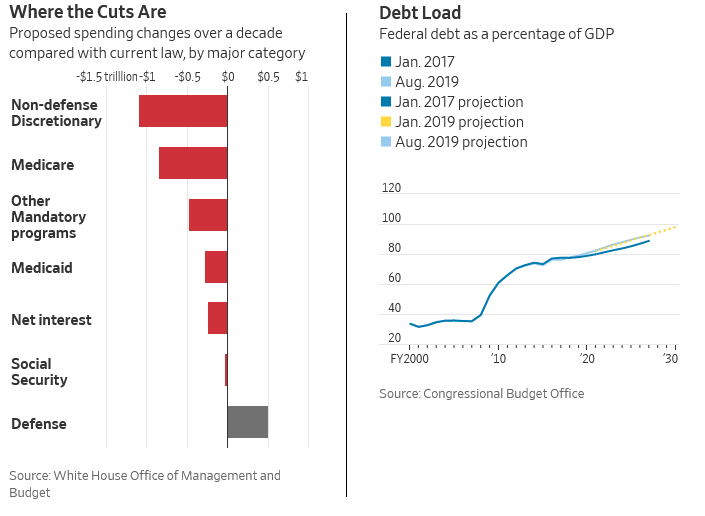White House Budget To Include ‘War On Waste’ While Boosting Spending On Military, Veterans, And Space
The Trump administration is expected to release a $4.8 trillion budget Monday which will include a ‘bold and detailed chapter on curbing waste, fraud, corruption and taxpayer abuse,’ according to Forbes‘ Adam Andrzejewski, who has seen an advance copy.
The plan would increase military spending 0.3% to $740.5 billion, while cutting non-defense spending by 5% to $590 billion, which falls below the level Congress and the Trump administration agreed to in a two-year budget deal last summer. The budget assumes that a 2017 tax-cut package is extended past its 2025 expiration, and projects revenues in line with last year’s proposal.
That said, the budget also assumes the economy will grow at 3% for the next 15 years, which seems more than a bit ambitious.
“The White House’s election-year budget will show the economy growing at an average rate of 3% for the next 15 years”…..we haven’t grown at 3% for a full calendar year since 2005 and we averaged 1.8% annual growth over the last 15 years.
— GreekFire23 (@GreekFire23) February 9, 2020
As the Wall Street Journal notes, “Among the agencies that would receive the biggest boost is NASA, which would see a 12% increase next year as Mr. Trump seeks to fulfill his goal of returning astronauts to the moon by 2024. On the other hand, the Environmental Protection Agency’s spending would be slashed by 26%.” The Department of Housing and Urban Development, meanwhile, will see its budget slashed by 15%, however as the Journal adds, the proposal includes $2.8 billion in homelessness assistance grants.
The Centers for Disease Control and Prevention would see its budget decline 9%, but with the coronavirus sparking global panic, $4.3 billion in funding for fighting infectious diseases would be preserved.
Separately, the administration has notified Capitol Hill that it might reprogram $136 million in funds from fiscal year 2020 to address the virus, the administration official said, though no decision has been made on whether the money is needed. –Wall Street Journal
Other winners include the Department of Veterans Affairs, which will receive a 13% boost next year, the National Nuclear Security Administration with a 19% boost, and the Department of Homeland Security, which will receive an additional 3%.

The plan would request $2 billion in new funding for construction of the wall the southern U.S. border, the senior administration official said—Mr. Trump’s signature 2016 campaign promise that sparked fights with Democrats in Congress, leading the president to trigger a historic five-week government shutdown last winter after lawmakers refused to fund the project. The latest $2 billion request is significantly less than the $5 billion the administration sought last year.
The White House proposes to cut spending by $4.4 trillion over a decade. Of that, it targets $2 trillion in savings from mandatory spending programs, including $130 billion from changes to Medicare prescription-drug pricing, $292 billion from safety-net cuts—such as work requirements for Medicaid and food stamps—and $70 billion from tightening eligibility access to federal disability benefits. –Wall Street Journal
Meanwhile, Forbes‘s Andrzejewski sums up “three of the non-partisan reforms the president will highlight in his FY2021 budget to Congress”:
1. End Improper Year-End Waste. The federal government’s use-it-or-lose-it year-end spending spree has been going on for years. In our recent oversight report, we found $97 billion spent by 67 federal agencies during the final month of fiscal year 2018. In the last week of the fiscal year, $53 billion in contracts went out the door – that’s one in every ten dollars spent in the entire year.
The year-end spending spree purchases included:
- Inflatable games ($42,500), model rockets ($34,000), china tableware ($53,004), alcohol ($308,994), musical instruments ($1.7 million), workout equipment ($9.8 million) and lobster tail and crab ($4.6 million).
- $300 million spent on passenger vehicles, trucks, motorcycles, scooters, and snowmobiles.
- $462 million spent on public relations, marketing research, and advertising.
- $491 million spent on furniture and redecorating federal agencies.
- $61.2 billion spent by the Pentagon in the final 30-days of the fiscal year.
2. Putting an End to Improper Payments. Each year, the twenty largest federal agencies admit to mistakenly paying out approximately $140 billion. For example, we found that nearly $1 billion was improperly paid to dead people. The Internal Revenue Service (IRS) improperly paid $18.4 billion through the earned income tax program last year.
Since 2005, we found the federal government has improperly paid $1.2 trillion from the U.S. Treasury.
3. Conducting Oversight of Spending. The Trump administration has already eliminated 31,000 duplicate contracts, saving taxpayers $27 billion since 2017. In the budget, they commit to doing more including comparison shopping, volume discounts, and negotiating better deals.
Read the rest of Andrzejewski’s report here.
Tyler Durden
Sun, 02/09/2020 – 19:35
via ZeroHedge News https://ift.tt/38fdVtR Tyler Durden